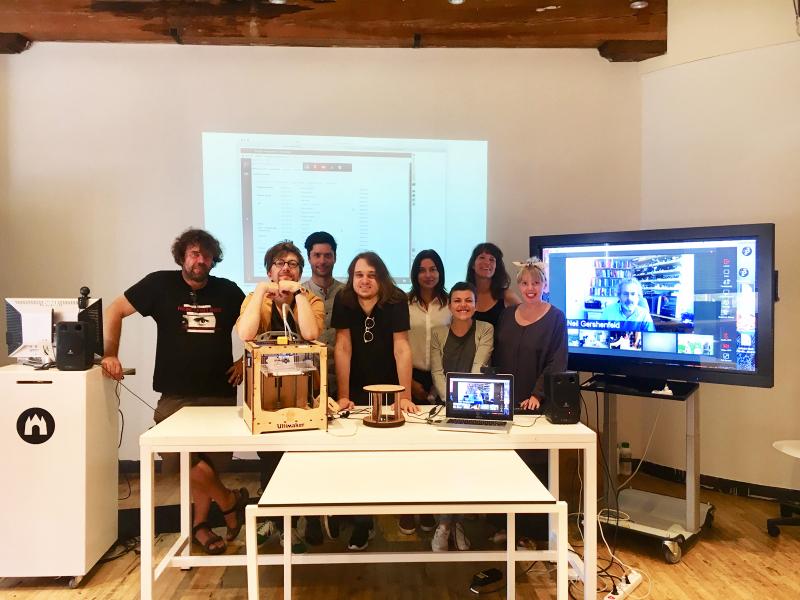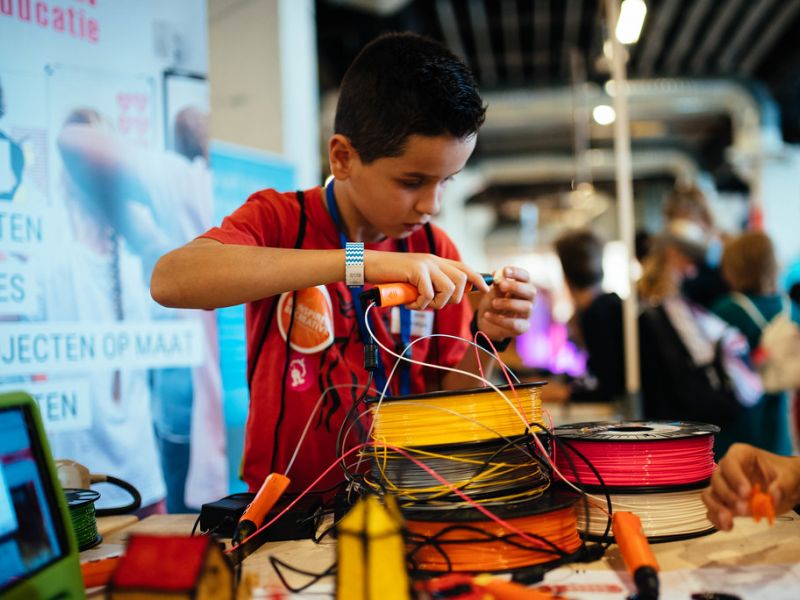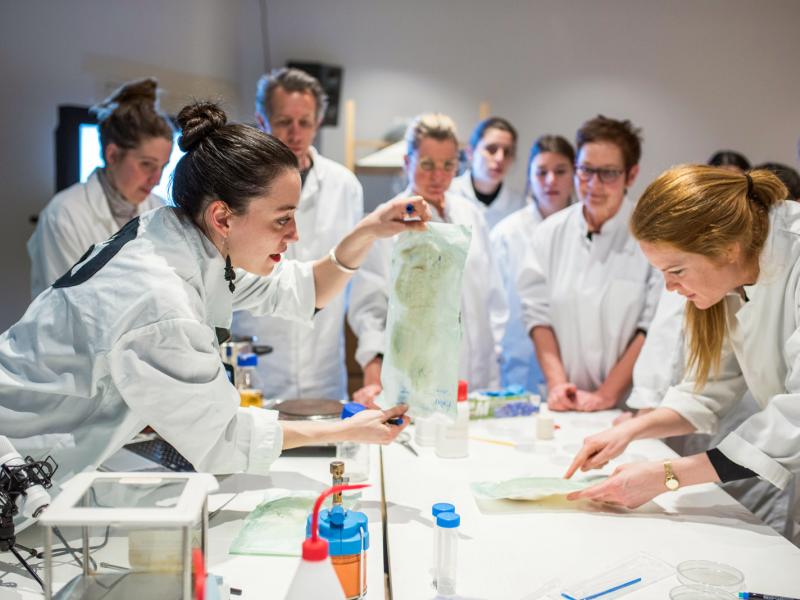Waag | technology & society is a public research organization, located in Amsterdam, the Netherlands where the citizens are the research community. ECHN met with project and concept developer Miha Turšič and discussed makers’ mobility.
Can you briefly describe your organization? Is your organisation addressed to makers, do you host makers activities?
Miha Turšič: Waag is a public research organization where we empower and equip citizens with everything that they need or cannot find on the market. Even if something doesn’t exist, we help them (learn to) make it by themselves. This way, we support makers with our activities in different fields.
For maker education, we contributed to the development of methodologies and infrastructure in Amsterdam, in collaboration with city library OBA and their branches, so that young people can learn how to make in these smaller makerspaces or Fab Labs.
We are also involved in different research activities that relate to citizens’ digital rights, environmental issues, or manufacturing, since citizens can make whatever they need or require in our facilities. We’re also very active in citizen sensing in a way that citizens can make their own sensors, for checking water or air quality. We are running a Hollandse Luchten project around the second largest steel factory in Europe where different initiatives, in different stages, learn how to sense the environment, how to make their own technology devices, how to use them, produce data and then engage with other stakeholders and policymakers.
The third field of our activities would be a more creative and critical one that is mostly connected with artists and thinkers, who literally question the foundations of technology. Using the methodology of critical making they are able to critically question these conditions in a practical way. So, they make something or produce an object of discussion that in some way analyses a technological issue.
Let’s say that these are the three main fields of how we engage with maker activities. Of course, there’s also another important one, which is maybe included in the context of maker education. We also have a Fabricacademy, working together with IAAC and some other labs and we also have a BioHack Academy, which is more engaged with biotechnology. We are also experimenting with a few other more creative academies on AI and on the environment, where making is a crucial part and the participants reflect around questions such as: “Who makes?” and “What’s required to make things?”. That could be briefly how Waag relates with maker practices.

Have you participated in any mobility programs for makers in the past? Can you elaborate on your experience(s)?
Miha Turšič: I don’t remember Waag being part of mobility projects. However, we support mobility in different ways, mainly through art residences, which allow artists and makers, since for us artists are also makers, to visit the Netherlands. For example, the Fab Academies and the Fabricacademy allow students from all around the world to come to Amsterdam, visit our lab and participate in the academies. Regarding mobility, the academies are one part of the activities and the other one is a variety of residency programmes. Some of them are locally funded like 3 package deal by Amsterdam Cultural Funds, others nationally funded and others are funded by the EU like STARTS residencies.
From your experience, what would be the challenges in mobility for makers?
Miha Turšič: First of all, and the most obvious one, is the visa for non-European makers. That’s usually a trouble and as an organization we have limited resources to support the makers in that. Depending on the circumstances, sometimes we can do it, while others we can’t. Another challenge would be to support families travelling, which I find really important, especially with residences. Can the makers come along with their family? If so, can we cover the costs of the family and not just of the individual maker?
We also had a case where a transgender artist came to the Netherlands and needed medicine. This was something that we needed to help them with, because this transgender person, came for a year and needed local support by local health organizations and different policies.
From your experience, would you like to add any good practices?
Miha Turšič: What is also important for us are the next steps. Sometimes the makers who visit us want to continue working with us and this aspect of career development is part of our efforts as well. For example, some students from the Fabricacademy are now our colleagues.
As a research organization we support makers, artists and creatives in a context that is usually not supported. It’s not always all about the production and making but for the step before that, which is research. While researching, makers don’t have to produce something, but they need to learn new things or improve their knowledge on the topic that they are planning to work on, so that they can be better prepared for the project. It is still quite rare to support makers’ and creatives’ research practices and research in general.
We also work with makers and artists in the early steps of their career and bring them closer to international networks, such as: festivals, exhibitions, conferences, and so on. This way, Waag acts as an entry point for different networks. Another thing that we do for students in the Netherlands is that we offer internships for them, so that they can learn more about the real world and we try to support, at least some of them, through their careers. For example, they can do one project and we can try to find ways to fund them, whether this is through our projects or fellowship programme at Waag. This way, they can work on their own funding, based on being acquainted with our organization.
Since we work a lot in collaborative research and innovation practices, we don’t just try to facilitate collaboration, but we try to develop some kind of collaborative innovation. We don’t just provide the space and funding for the artists to do something by themselves, but also guide them through the methodologies and tools that they need to produce something that otherwise couldn’t do as individuals. It’s a form of innovation management. We contribute and support the project and also teach in a way.
How do mobility experiences bring value to your organization and community?
Miha Turšič: We learn from our communities, that’s the main thing. They offer their input and they produce things in a unique individual way, while through the critical making process, they go even farther. They can be more critical, they can be more challenging toward policymakers, the industry, or whatever topic they decide. For this reason, when we host an artist that works on an urgent question, we try to introduce them to our citizens and community.
Maybe it’s also important to mention that Waag is a Future Lab in the Netherlands, which is a title given by the Ministry of Culture. This way, we facilitate the engagement between citizens and creatives and everything that happens between them through different types of activities. We don’t look for the benefits of the organization, but we mainly focus on the benefits that there are for the citizens because that’s who we serve.
Is mobility a chance for better connecting with the local community?
Miha Turšič: It’s never enough I would say. I mean, Waag is located in Amsterdam, which is a city that attracts a lot of tourists and its infrastructure is used for tourism. As Future Lab we try to engage even more with the neighbourhood, working with citizens and local communities. However, we would love to be even more engaged locally, to be really close to the needs of people and for this reason, at the moment we are part of two projects, one is T-Factor and the other one is CENTRINNO.
These are two projects that focus in specific neighbourhoods. On one project, we engage with the local makers and traditional craftspeople and on the other one, we focus more on the environmental aspect, working not only with citizens but with plants and bacteria as well, because in the context of the project, we understand them as co-inhabitants of the same space. Also, artists play a crucial role, helping us see, observe and connect with something non-human in this case.

What would be a dream mobility scheme for makers? Would you give priority to travel support, social encounters, technical access or network building?
Miha Turšič: I think that this would be more of a question for them. I would approach it this way, asking them to tell us what they prefer, because we are supposed to be those who provide these things. What I see important in this context is that they are paid for their work. Usually, mobility is just part of the cost of the whole effort. I would prefer that when somebody is providing a mobility opportunity, they would also provide all the needed conditions and resources for the artists to participate. For example, coming to the place, living there, doing your job, and then moving on. It would be important for makers to have a form of social security to do these activities.
What is mobility in times of world pandemics? Should we still invest in that? And, considering our travel restrictions, how can we continue to grow and reinforce networks, if we cannot meet one another? And why is that important (or not)?
Miha Turšič: The fact that we cannot meet in person doesn’t prevent us from meeting virtually. A lot of efforts have been made towards that, such as remote workshops or educational activities. Again, coming back to my previous answer, having social security for all these activities is crucial, despite traveling isn’t possible. In these situations where we cannot travel, this kind of funding can be used to support the same activities online. Despite the fact that you cannot visit the actual place you can still do your work. There should be some kind of flexibility there.
Makers’ and artists’ mobility contributes to the society, so it’s not always about the benefit that they can personally get. Whatever they produce, if properly disseminated, can also bring back to society. However, it comes down to the organisations to facilitate that. If they care for it, then the projects can have an impact on society.

